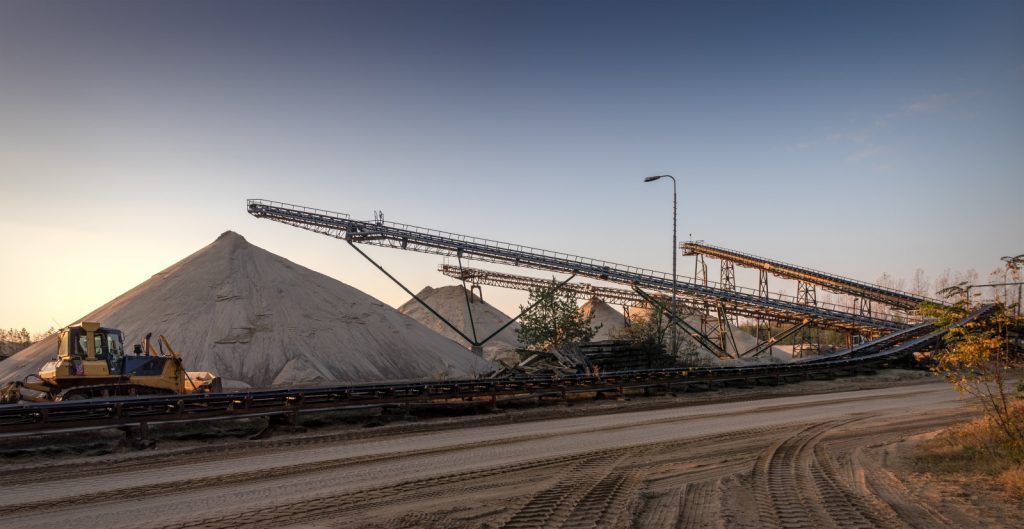Heavy Construction Conveyor Engineering Guide

For big civil engineering and infrastructure projects, construction conveyors may be a better choice than front-end loaders and haul trucks. A construction conveyor moves aggregate, bulk rock, and borrow material quickly and efficiently. It takes up little space, can avoid existing traffic flows, and has less environmental impact. Plus, it doesn’t need drivers.
Keep reading for a heavy construction conveyor engineering guide that will tell you what you need to know. Individual sections address:
- Material transport requirements
- Material considerations
- Conveyor capacity
- Conveyor drives
- Loading and unloading
- Project planning
MATERIAL TRANSPORT REQUIREMENTS
A construction conveyor may be the solution when you need to move material between two places. This often happens in highway construction projects, when excavating for deep foundations/underground parking, and building massive structures like dams, sea defenses and harbor piers.
A major advantage of conveyors is they can go around or over obstacles. In highway construction, for example, it may be necessary to move borrow materia (ex: riprap, road base, sand, gravel, fill, boulders) from one side of an existing road to the other. A conveyor can run above the road, avoiding the disruption to traffic and safety issues that would result from using trucks and front-end loaders.
Conveyor end locations aren’t fixed as both loading and unloading points can be extended and contracted as needed.
MATERIAL CONSIDERATIONS
The properties of the aggregate or other bulk material dictate every aspect of heavy construction conveyor design except length. In particular, the conveyor system designer needs to know the weight and volume of material to be moved, in tons per hour, as well as the repose angle.
Getting the weight can be a challenge in industries more familiar with working in cubic yards. There are tables that provide guidance but it’s always best to have the material tested. Testing will also reveal the repose angle – the steepest it can be piled – and this also influences conveyor design, particularly troughing height or depth.
Other important factors are how wet the material will be, and whether it’s sticky or especially abrasive. Sticky material may require extra consideration given to adding scrapers to the belt system. Abrasive materials will need tougher belt covers and perhaps also better roller-idler bearing protection.
CONVEYOR CAPACITY
Project timing/duration and material properties together determine the tons per hour the conveyor has to move. Material density and repose angle will determine belt width and speed and troughing.
A wider belt is often preferable to a higher speed as this prolongs component life. However, in a short-duration project speed might win out.
CONVEYOR DRIVES
The drives comprise the motor or motors plus couplings and the reducer or gearbox that delivers the torque and speed needed. The least expensive is the chain-driven drive. Alternatives are the shaft-mounted reducer belt drive, combination belt drives with take-up units, and alignment-free drives.
Alignment-free drives typically provide the longest life and lowest overall operating costs. When installation cost is the main concern though, a chain-driven or combination drive may be the way to go.
Motor sizing is determined mostly by the tons per hour to move plus the belt length. The motor will be selected in conjunction with the reducer to provide the torque and horsepower required.
LOADING & UNLOADING
Consider how the material will be dropped onto the belt, and how it will be handled at the unloading end. Loading is typically done via transfer chute and rockbox.
With this approach, a front-end loader drops material into the top of the chute with the rockbox inside slowing its fall and guiding it onto the belt. This spreads material out and reduces impact load.
At the unloading end, a stacker conveyor is often the preferred method. This raises the material and drops it onto a pile. Stacker conveyors are available in radial, telescoping, and radial telescoping formats. The last of these, in particular, can reduce the amount of other handling work needed.
PROJECT PLANNING
Lead time on a heavy construction conveyor is typically around four months, although installation challenges may extend this.
Installation must be considered carefully during the planning phase. A construction conveyor is used on a project with a finite life: if designed for portability, (key components being skid-mounted,) it can be reused on many other projects. When first commissioning a construction conveyor, consider what features might increase its flexibility and utility.
HEAVY CONSTRUCTION CONVEYORS FROM WEST RIVER CONVEYORS
Virtually every construction project of any size involves moving bulk materials. In projects like these, a conveyor offers many advantages over relying on a fleet of trucks. It’s safer and often more convenient, it also reduces dust and noise, (a concern on construction sites in residential or urban areas,) and avoids the expense and difficulty of employing drivers.
While a heavy construction conveyor has features in common with overland conveyors and those used in mines and at ports and quarries, it also has some differences. These relate to the relatively short duration of the project and the potential benefits of incorporating flexibility and portability into the design.
In this heavy construction conveyor engineering guide, we have identified the principal aspects to consider, but there are many more points to work through.
As conveyor specialists, we can draw on decades of experience to guide our design, engineering, and construction work. If you’d like to learn more about construction conveyors and what they could do for you, click below.

